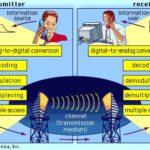Telecommunication, science and practice of transmitting information by electromagnetic means. Modern telecommunication centres on the problems involved in transmitting large volumes of information over long distances without damaging loss due to noise and interference. The basic components of a modern digital telecommunications system must be capable of transmitting voice, data, radio, and television signals. Digital transmission is employed in order to achieve high reliability and because the cost of digital switching systems is much lower than the cost of analogy systems. In order to use digital transmission, however, the analogy signals that make up most voice, radio, and television communication must be subjected to a process of analogy-to-digital conversion.

As described in Source encoding, one purpose of the source encoder is to eliminate redundant binary digits from the digitized signal. The strategy of the channel encoder, on the other hand, is to add redundancy to the transmitted signal—in this case so that errors caused by noise during transmission can be corrected at the receiver. The process of encoding for protection against channel errors is called error-control coding. Error-control codes are used in a variety of applications, including satellite communication, deep-space communication, mobile radio communication, and computer networking.
Analogy-To-Digital Conversion:
In transmission of speech, audio, or video information, the object is high fidelity—that is, the best possible reproduction of the original message without the degradations imposed by signal distortion and noise. The basis of relatively noise-free and distortion-free telecommunication is the binary signal. The simplest possible signal of any kind that can be employed to transmit messages, the binary signal consists of only two possible values. These values are represented by the binary digits, or bits, 1 and 0. Unless the noise and distortion picked up during transmission are great enough to change the binary signal from one value to another, the correct value can be determined by the receiver so that perfect reception can occur.
Sampling:
Analogy-to-digital conversion begins with sampling, or measuring the amplitude of the analogy waveform at equally spaced discrete instants of time. The fact that samples of a continually varying wave may be used to represent that wave relies on the assumption that the wave is constrained in its rate of variation. Because a communications signal is actually a complex wave—essentially the sum of a number of component sine waves, all of which have their own precise amplitudes and phases—the rate of variation of the complex wave can be measured by the frequencies of oscillation of all its components.
Quantization:
In order for a sampled signal to be stored or transmitted in digital form, each sampled amplitude must be converted to one of a finite number of possible values, or levels. For ease in conversion to binary form, the number of levels is usually a power of 2—that is, 8, 16, 32, 64, 128, 256, and so on, depending on the degree of precision required. In digital transmission of voice, 256 levels are commonly used because tests have shown that this provides adequate fidelity for the average telephone listener.
Source Encoding:
As is pointed out in analogy-to-digital conversion, any available telecommunications medium has a limited capacity for data transmission. This capacity is commonly measured by the parameter called bandwidth. Since the bandwidth of a signal increases with the number of bits to be transmitted each second, an important function of a digital communications system is to represent the digitized signal by as few bits as possible—that is, to reduce redundancy. Redundancy reduction is accomplished by a source encoder, which often operates in conjunction with the analogy-to-digital converter.

